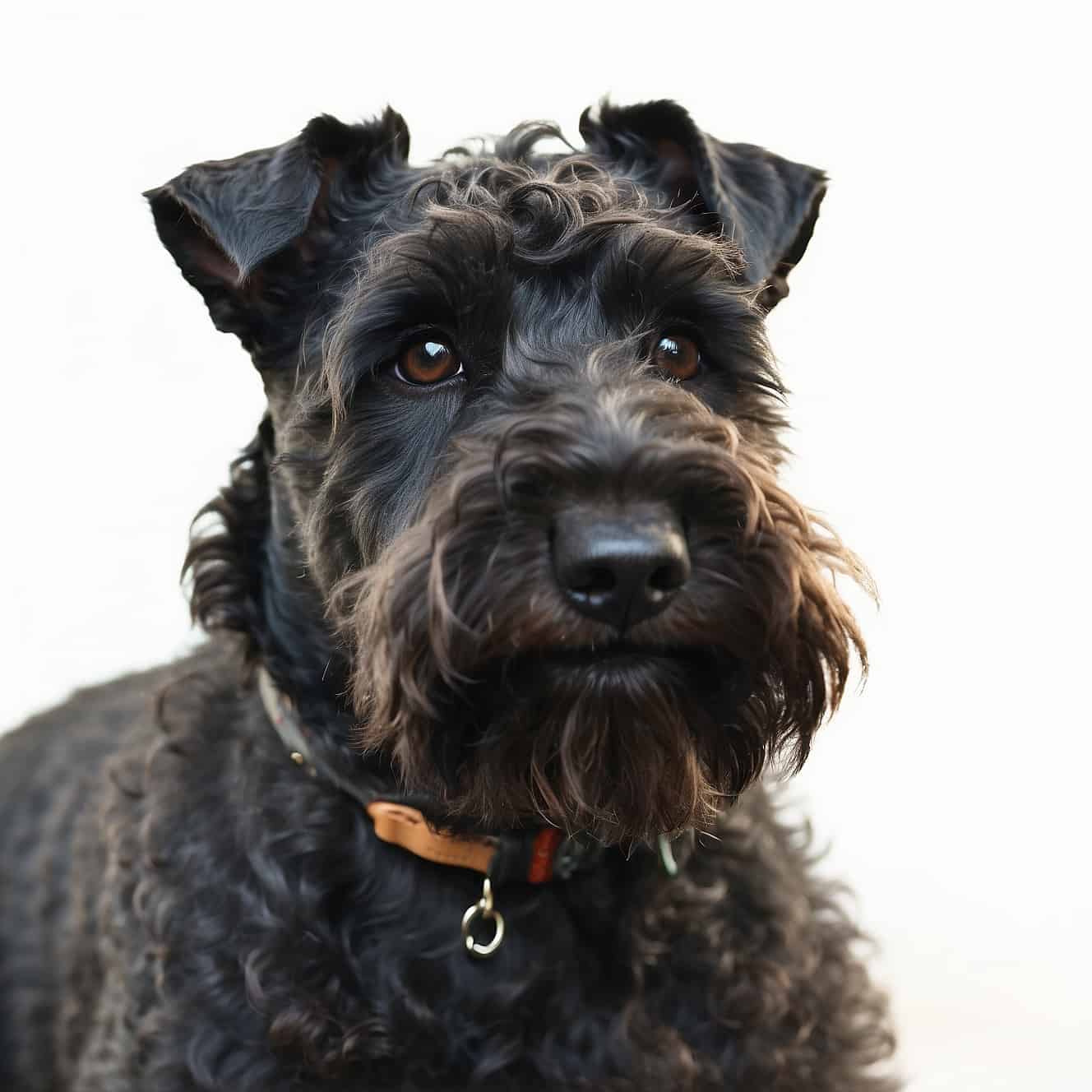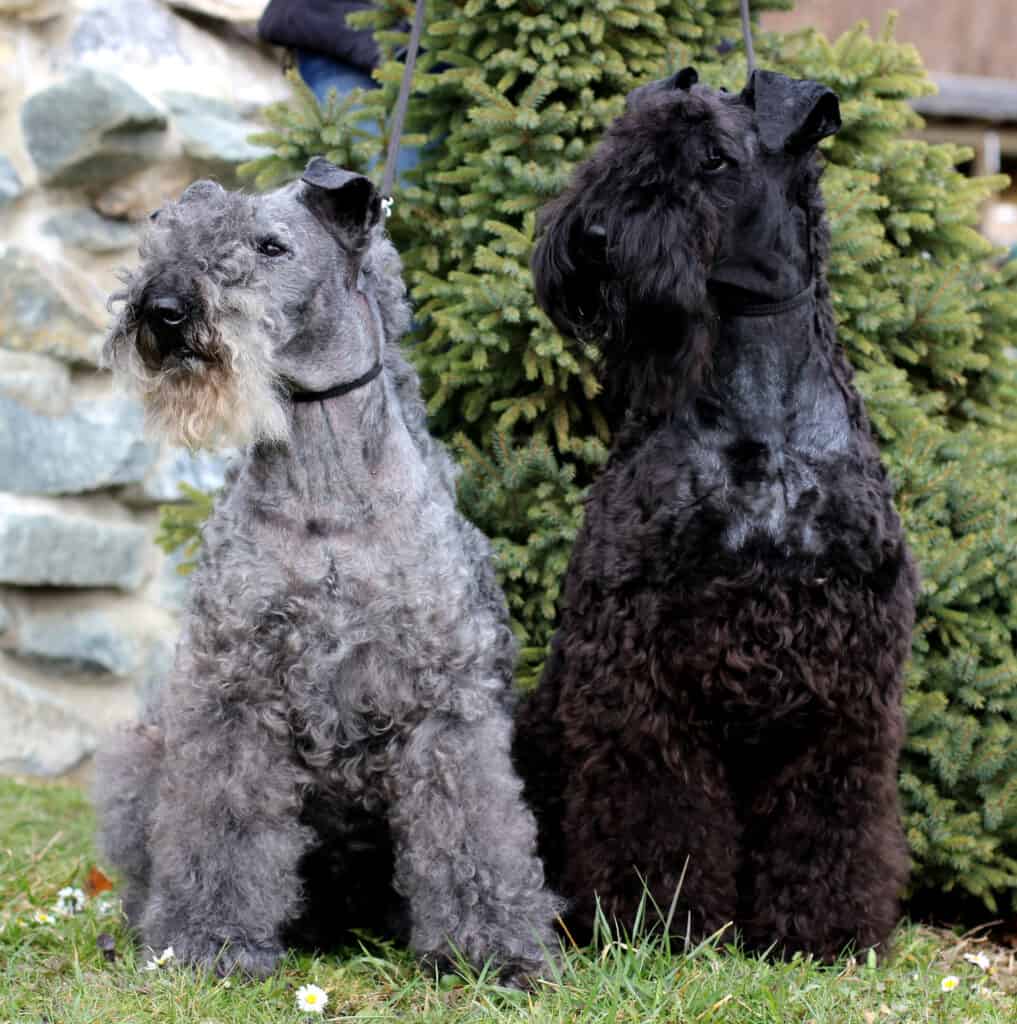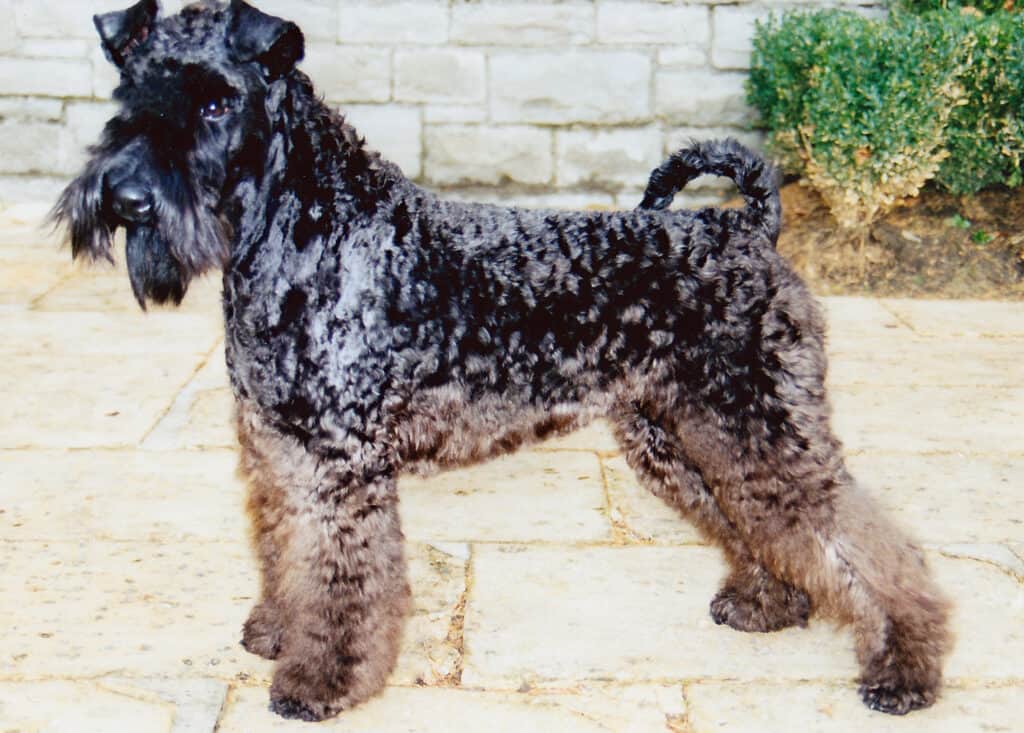The Kerry Blue Terrier, with its striking blue coat, is a versatile and spirited breed originating from Ireland. Known for its intelligence and adaptability, this terrier excels in various roles, from a skilled hunter to a devoted family companion. With a charming personality and a distinct appearance, the Kerry Blue Terrier captures hearts with its unique blend of elegance and athleticism.

| Category (Explanation) | Breed Information |
|---|---|
| Year of Breed Conception | 18th century |
| Country of Origin | Ireland |
| Weight (lbs & kg) (Male) | 33-40 lbs (15-18 kg) |
| Weight (lbs & kg) (Female) | 33-40 lbs (15-18 kg) |
| Coat Type | Soft, dense, curly coat |
| Color Variations | Blue-gray |
| Shedding Level (Low, Moderate, High) | Low to Moderate |
| Height (cm & in) | 17.5-20 inches (44-51 cm) |
| Breed Size | Medium |
| Trainability (Low, Moderate, High) | High |
| Mental Needs (Low, Moderate, High) | Moderate |
| Intelligence Level (Low, Moderate, High) | High |
| Energy Level (Low, Moderate, High) | Moderate |
| Agility (Low, Moderate, High) | High |
| Loyalty (Low, Moderate, High) | High |
| Playfulness (Low, Moderate, High) | High |
| Exercise Needs | Regular exercise and playtime |
| Guarding Proficiency (Low, Moderate, High) | Moderate |
| Sociability with Children (Low, Moderate, High) | High |
| Barking Level (Low, Moderate, High) | Moderate |
| Digging Tendency (Low, Moderate, High) | Moderate |
| Destructive Behavior (Low, Moderate, High) | Low |
| Drooling Level (Low, Moderate, High) | Low |
| Obedience Level (Low, Moderate, High) | High |
| Apartment Friendly (Yes/No) | Can adapt to apartment living with sufficient exercise |
| Inherent Prey Drive | Moderate |
| Physical Risk to Others (Low, Moderate, High) | Low |
| Travel Fatality Risk (Low, Moderate, High) | Low |
| Allergen Potential | Low |
| Health Concerns (List of Common Health Concerns) | Hip Dysplasia, Cataracts, Skin Issues |
| Average Life Expectancy (Life Expectancy in Years) | 12-15 years |
Woof Mastery is reader supported and our articles may contain affiliate links.
Instead of running third party ads that we have no control of we only use links from high-quality companies we are directly partnered with. Making use of these links come at no cost to you our reader, and in many cases have the extra benefit of discounted rates or sign up bonuses.
If you’re interested you can read more about our affiliate policy here.
We appreciate your support and always insure that the products and services we recommend are high-quality, helpful and relevant to the subject at hand!
The Kerry Blue Terrier, originating from Ireland, has a history intertwined with its role as a versatile working dog. Developed in the 18th century, this terrier was valued for its ability to excel in various tasks, including herding, hunting, and guarding. The breed’s distinctive blue coat emerged as a result of selective breeding. Over time, the Kerry Blue Terrier transitioned into a beloved companion, known for its intelligence, loyalty, and charming personality. Today, it stands as a symbol of Irish heritage and is appreciated for its multifaceted abilities.

The Kerry Blue Terrier is recognized for its striking blue coat and versatility. Special qualities include its intelligence, adaptability, and affectionate nature. This terrier excels in various roles, from herding to being a loving family companion. What sets it apart is its ability to balance a spirited personality with a deep loyalty to its family. The Kerry Blue Terrier’s unique coat and multifaceted abilities contribute to its special status as a beloved and dynamic member of households around the world.
The Kerry Blue Terrier’s traditional role originated in Ireland, where it was developed in the 18th century for herding, hunting, and guarding. Known for its distinctive blue coat, this terrier excelled in various tasks on farms. Over time, it transitioned into a beloved family companion, valued for its intelligence and loyalty. Today, the Kerry Blue Terrier continues its traditional role as a versatile and spirited companion, representing Irish heritage and making a positive impact in households worldwide with its friendly demeanor and multifaceted abilities.
Kerry Blue Terriers are known for their striking appearance and versatile personalities. They are intelligent, adaptable, and affectionate. These terriers have a spirited nature and can excel in various roles, from herding to being loving family companions. Kerry Blue Terriers form strong bonds with their families and are often described as loyal and friendly. With proper training and socialization, they showcase a balanced personality, combining energy with a deep sense of loyalty. Their distinctive blue coat and multifaceted abilities make them beloved members of households around the world.
Kerry Blue Terriers are known for their versatile and spirited temperament. They are intelligent, adaptable, and can be affectionate with their families. Early training is essential to manage their energetic nature. Kerry Blue Terriers may be reserved with strangers, emphasizing the need for proper socialization. Their history as working terriers requires regular mental and physical stimulation. While they can get along well with children, supervision is recommended due to their exuberance. With consistent training and positive interactions, Kerry Blue Terriers develop into loyal and loving family members, showcasing a well-adjusted temperament.
Kerry Blue Terriers are medium-sized dogs with a muscular and well-balanced build. They have a distinctive head with a flat skull and a moderate stop. Their eyes are dark and alert, and their ears are small and folded forward. The breed is known for its soft, wavy, and non-shedding coat, which is blue-gray at maturity. Kerry Blue Terriers have a straight back, a high-set tail, and a confident gait. They convey a sense of intelligence, agility, and style.
Kerry Blue Terriers are known for their unique blue-gray coat, which gives them a distinguished and stylish appearance. The breed’s coat color is solid blue-gray at maturity, creating a sleek and uniform look. The blue coloration is a distinctive feature of Kerry Blue Terriers and contributes to their overall elegance and charm.
Kerry Blue Terriers are known for their blue-gray coat, which is a defining feature of the breed. The coat is soft, wavy, and non-shedding, and the blue-gray color is relatively uniform across individuals. While variations in shade may occur, the breed standard emphasizes the blue-gray hue. Kerry Blue Terriers should have no other coat patterns or colors, maintaining a consistent appearance that contributes to their stylish and elegant presence.
Kerry Blue Terriers have a low shedding level. Their soft, wavy coat sheds minimally, and regular grooming is important to prevent matting and maintain coat health. Brushing the coat a few times a week helps remove loose fur and keeps the coat in good condition. While Kerry Blue Terriers are not heavy shedders, consistent grooming practices contribute to the well-being of their distinctive coat.
Kerry Blue Terriers have a unique curly coat that requires specific grooming practices to maintain its quality. Grooming habits for Kerry Blue Terriers include:
Brushing: Regular brushing with a slicker brush or a comb is necessary to prevent matting and tangling. Brushing should be done at least a few times a week.
Bathing: Kerry Blue Terriers should be bathed regularly, approximately every three to six weeks, to keep their coat clean and healthy. Use a dog shampoo suitable for curly coats.
Ears: Check and clean their ears regularly to prevent wax buildup or infections. Use a damp cotton ball or a veterinarian-recommended ear cleaning solution.
Nails: Keep their nails trimmed to a comfortable length to prevent discomfort and maintain proper foot health.
Teeth: Brush their teeth regularly with a dog-friendly toothbrush and toothpaste to prevent dental issues. Dental chews or toys can also contribute to oral health.
Eye Care: Monitor their eyes for signs of irritation or discharge. If necessary, use a damp cloth to clean around the eye area.
Kerry Blue Terriers have a moderate to high activity level. These versatile terriers enjoy regular exercise, including walks, playtime, and activities that challenge them physically. Providing mental stimulation through training sessions and interactive toys is important for their well-being. Kerry Blue Terriers may excel in various dog sports and activities, making them suitable for owners who enjoy an active lifestyle.
Kerry Blue Terriers are known for their intelligence and versatility. Their problem-solving skills and adaptability make them suitable for various roles. Training should be approached with positive reinforcement, and mental stimulation is crucial to keep them engaged. Their intelligence is complemented by a spirited personality that adds charm to their overall demeanor.
Kerry Blue Terriers thrive on mental engagement. Provide activities that challenge their intellect, such as puzzle toys and training exercises. Regular social interaction is essential, as they are social dogs. Obedience training not only mentally stimulates them but also strengthens the owner-dog bond. Creating a routine, offering affection, and providing a safe environment contribute to their mental well-being.
Enter The Woof Mastery

Before welcoming a Kerry Blue Terrier into your home, consider the following:
Kerry Blue Terriers, known for their distinct coat and energetic nature, may pose a risk if not properly trained and socialized. Early training and consistent socialization can help manage their behavior, ensuring they are comfortable around people and other pets. Owners should be responsible and aware of their dog’s interactions in various settings.
Kerry Blue Terriers, known for their distinctive coat, can be good family pets. Supervision is important, especially due to their energy levels. Proper socialization from an early age is essential to ensure they interact well with children. Obedience training can help curb any exuberant behavior, and they may form strong bonds with the kids in their family.
Kerry Blue Terriers may have mixed responses to water. While some may enjoy swimming, others may not be as comfortable. Introduce them to water slowly and provide positive reinforcement. Always prioritize safety and use a canine life vest if needed, especially in situations where they may be at risk of fatigue.
Remember that Kerry Blue Terrier puppies, like all puppies, are eager to please and learn. Positive and consistent training practices will help them become well-behaved, obedient, and happy adult dogs. Building a strong and trusting bond with your puppy through training is a rewarding experience for both you and your canine companion.
Kerry Blue Terriers are known for their intelligence and independence. While they are not excessive barkers, they may bark to alert their owners or express themselves. Training and socialization are crucial to shaping their behavior and preventing unwanted barking.
Kerry Blue Terriers thrive in homes with active families. They do well in houses with yards but can adapt to apartment living with regular exercise. Regular grooming is necessary for their distinctive coat. Socialization is crucial to prevent aggressive behavior. Positive reinforcement training is effective in shaping their behavior.
When traveling with Kerry Blue Terriers, consider their size and potential anxiety during travel. Use a secure travel crate that allows them to stand, turn, and lie down comfortably. Provide familiar items for comfort. Plan for breaks during the journey to address their energy levels and anxiety. For air travel, choose airlines with policies accommodating their size, and ensure compliance with crate requirements for safety.
Kerry Blue Terriers may be prone to specific health concerns. While not all individuals will experience these issues, it’s crucial for Kerry Blue Terrier owners to be aware of potential health problems and collaborate with veterinarians to maintain their pets’ well-being. Common health concerns in Kerry Blue Terriers include:
Regular veterinary check-ups, a balanced diet, dental care, and responsible breeding practices can contribute to the overall well-being of Kerry Blue Terriers. Owners should be proactive in monitoring their pets’ health and seeking veterinary attention if any concerns arise.
Proper nutrition is crucial for the health and well-being of Kerry Blue Terriers. Here are some nutritional habits and best practices to consider for this breed:
Breed-Specific Laws (BSL): Kerry Blue Terriers may be subject to breed-specific laws (BSL) in certain areas. These laws are often enacted at the local or municipal level and can vary widely from one jurisdiction to another.
Types of Restrictions: The specific restrictions imposed on Kerry Blue Terriers under BSL can include mandatory spaying/neutering, special licensing, liability insurance requirements, muzzling in public, and, in some cases, bans on ownership. The severity of these restrictions depends on local regulations.
Rationale for BSL: BSL is typically implemented based on concerns about public safety and perceived risks associated with specific breeds, often due to incidents involving dog attacks. While Kerry Blue Terriers are not inherently aggressive, they can be affected by BSL due to their physical resemblance to breeds that are sometimes included in these laws.
Controversy: It’s important to note that BSL is a controversial topic. Critics argue that it unfairly targets breeds rather than addressing individual dog behavior and that responsible ownership and training should be emphasized instead of breed-specific restrictions.
Local Regulations: To determine if there are breed-specific laws or restrictions regarding Kerry Blue Terriers in your area, you should check with your local animal control or government authorities. Be aware of and comply with any local regulations to ensure that you are in compliance with the law while owning a Kerry Blue Terrier.
Woof Mastery is reader supported and our articles may contain affiliate links.
Instead of running third party ads that we have no control of we only use links from high-quality companies we are directly partnered with. Making use of these links come at no cost to you our reader, and in many cases have the extra benefit of discounted rates or sign up bonuses.
If you’re interested you can read more about our affiliate policy here.
We appreciate your support and always insure that the products and services we recommend are high-quality, helpful and relevant to the subject at hand!
Myth 1: Kerry Blue Terriers are Aggressive
Myth 2: They are Not Good with Children
Myth 3: They are High-Maintenance Grooming
Myth 4: Kerry Blue Terriers are Not Intelligent
Myth 5: They Don’t Need Exercise
Myth 6: They are Always Reserved with Strangers
Myth 7: Kerry Blue Terriers are All the Same
Myth 8: They are Prone to Aggressive Behavior with Other Dogs
Myth 9: Kerry Blue Terriers Cannot Live in Apartments
Myth 10: They Don’t Form Strong Bonds with Owners
Understanding the realities of Kerry Blue Terriers helps dispel myths and ensures that potential owners can provide the right environment and care for these wonderful dogs.
Famous Kerry Blue Terrier owners include:
Conan O’Brien: The television host Conan O’Brien has a Kerry Blue Terrier named Mac. Mac has made appearances on O’Brien’s shows and has become a beloved figure among fans.
The Kerry Blue Terrier is culturally significant as a breed with a distinctive appearance and versatile abilities. Recognized for their elegant blue coat and friendly demeanor, Kerry Blues have found roles as both working dogs and companions. Their presence in popular media, as well as their historical ties to Ireland, contributes to their cultural appeal. Kerry Blue Terriers are symbols of agility and charm, finding appreciation among those who value their unique qualities.
The Kerry Blue Terrier is culturally significant as a breed with a distinctive appearance and versatile abilities. Recognized for their elegant blue coat and friendly demeanor, Kerry Blues have found roles as both working dogs and companions. Their presence in popular media, as well as their historical ties to Ireland, contributes to their cultural appeal. Kerry Blue Terriers are symbols of agility and charm, finding appreciation among those who value their unique qualities.
Kerry Blue Terriers, like many terrier breeds, have faced specific challenges and considerations. Some of the notable challenges include:
The Kerry Blue Terrier is an Irish breed known for its distinctive blue coat. Contributing breeds may include:
Kerry Blue Terriers are charismatic and adaptable companions known for their distinctive coat and lively personality. Their friendly and affectionate nature makes them excellent family pets, while their intelligence and energy benefit from engaging activities. Their versatility allows them to thrive in various living environments, bringing joy to urban and suburban households alike. Understanding their need for mental stimulation and providing them with opportunities for interaction strengthens the bond they form with their families, making them cherished additions to any home.